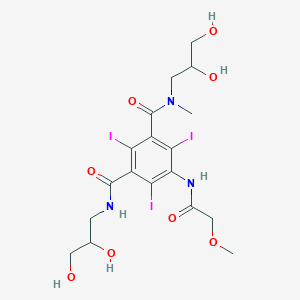Cerebral arteriography
Adult: As 300 mg iodine/mL: Carotid artery visualisation: 3-12 mL. Vertebral artery visualisation: 4-12 mL. Aortic arch inj: 20-50 mL. Max dose for procedure: 150 mL.
Intra-arterial
Aortography and visceral angiography
Adult: As 370 mg iodine/mL: Volume and rate of administration are based on the blood flow and specific characteristics of vessels being studied. Max dose for procedure: 225 mL.
Intra-arterial
Peripheral arteriography
Adult: As 300 mg iodine/mL: Subclavian or femoral artery: 5-40 mL. Aortic bifurcation for distal runoff: 25-50 mL. Max dose for procedure: 250 mL.
Intra-arterial
Coronary arteriography and left ventriculography
Adult: As 370 mg iodine/mL: Left or right coronary artery: 3-14 mL. Left ventricle: 30-60 mL. Max dose for procedure: 225 mL.
Intravenous
Contrast-enhanced computerised tomography
Adult: As 300 mg of iodine/mL: Head: 50-200 mL via IV inj. Max dose for procedure: 200 mL. Body: As single phase inj, 50-200 mL via IV bolus inj; 100-200 mL via rapid infusion. Max dose for procedure: 200 mL. As multiple phase inj, 50-200 mL via IV inj. Max dose for procedure: 200 mL. As 370 mg of iodine/mL: Head: 41-162 mL via IV inj. Max dose for procedure: 162 mL. Body: As single phase inj, 41-162 mL via IV bolus inj; 81-162 mL via rapid infusion. Max dose for procedure: 162 mL. As multiple phase inj, 41-162 mL via IV inj. Max dose for procedure: 162 mL.
Child: >2 years As 300 mg iodine/mL: 1-2 mL/kg. Max dose for procedure: 3mL/kg.
Child: >2 years As 300 mg iodine/mL: 1-2 mL/kg. Max dose for procedure: 3mL/kg.
Intravenous
Excretory urography
Adult: As 300 mg iodine/mL: 1 mL/kg via IV infusion. Max dose for procedure: 100 mL.
Child: >2 years As 300 mg iodine/mL: 1-2 mL/kg. Max dose for procedure: 3mL/kg.
Child: >2 years As 300 mg iodine/mL: 1-2 mL/kg. Max dose for procedure: 3mL/kg.




 Sign Out
Sign Out




